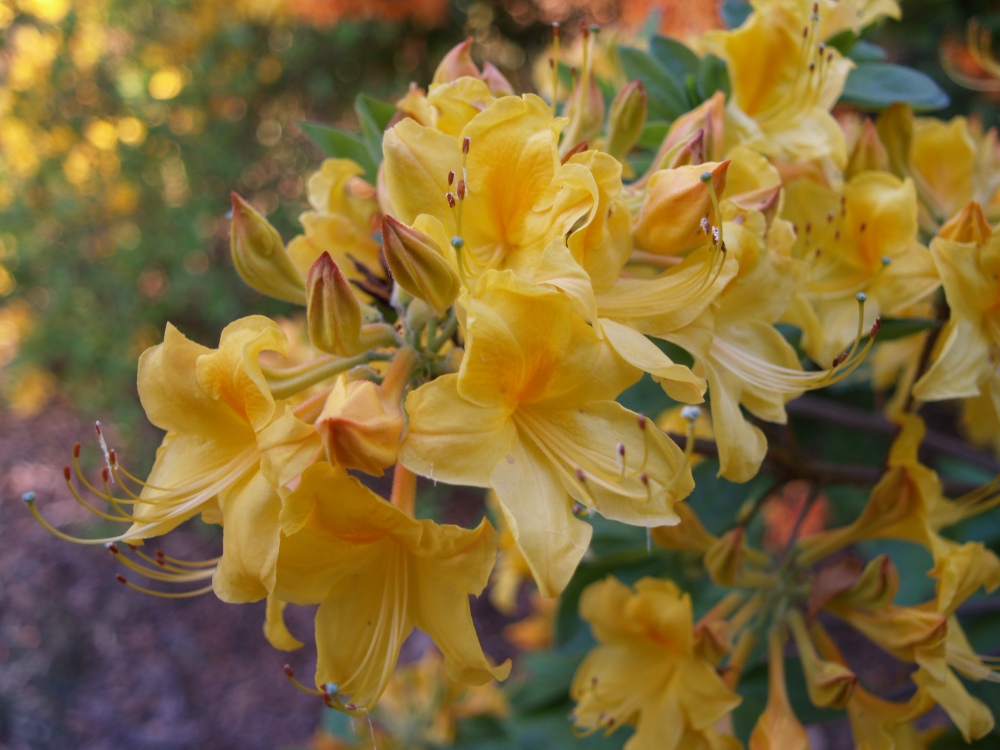I’m not much on looking back, perhaps because my memory is so poor I often can barely recall if something happened a year ago, or three. In any case, it seems to do little good to look backwards. Of course, there are lessons learned through successes and failures, but I gain little from this annual evaluation. My concerns are the impending cold that might endanger marginally cold hardy plants, and winter weeds that have become an increasing problem in recent years.
My biggest worry is that the lower garden has become increasingly damp in recent years. Long established witch hazels (Hamamelis x intermedia) and paperbushes (Edgeworthia chrysantha, below) showed signs of decline through the rainy late summer, and my hope is that this situation works itself out. There seems little that I can do to remedy the problem, but these things often turn out for the best without any intervention, so at this point I’m not overly concerned.

I’m quite certain that few gardeners are ever completely satisfied with the state of their gardens, but as long as I’m able to content myself by planting a few cherished items each year I’m able to overlook minor catastrophes, and ones that are imminent. When a tree is damaged by snow or ice, or is blown over in a gale, I look forward to its replacement. Over the past few years a few long delayed, but unavoidable projects to correct minor disasters were undertaken that have proved to be mostly successful. Following the demolition there was an opportunity to plant more extensively than in the previous decade.
On one side of the property a small grove of variegated bamboo spread past the point that could be tolerated, and my wife got the project off to a splendid start by chopping to the ground a large section of the canes along the driveway while I was traveling on business. The unsightly mess left only one alternative, and over the next few weeks the remainder of the bamboo was cut down and disposed of. The roots were left in place so that other trees and shrubs in the vicinity would not be damaged, so there was concern that the bamboo’s regrowth would delay new planting in the area for a year or two.
Fortunately, the regrowth has been easily managed, so I’ve replanted the area with a variety of evergreens, shrubs, ferns, and perennials. This spring, I look forward to enjoying the hellebores, hydrangeas, and azaleas, and even before it has begun to fill in I prefer this new planting rather than the bamboo. On the opposite side of the property, a tangled thicket of brambles and invading vines required hours of labor to chop out mulberries, multiflora roses, and the noxious Oriental bittersweet vine.
I took the liberty to carve out a bit of additional space, which has been planted with catalpa (Catalpa speciosa), Sweetbay magnolia (Magnolia virginiana, above), and an assortment of native shrubs. And, in one small spot that is as sunny as it gets on this side of the garden, a small Floating Cloud Japanese maple (Acer palmatum ‘Ukigumo’, below) was planted.
Several years ago a maple labelled ‘Ukigumo’ was planted while dormant in the rear garden, but when it leafed out it was only green without the white and pink variegation. The one I planted in late summer was in leaf, so I’m certain that it is correct, but it’s awful small and this slow growing Japanese maple is not likely to make much of an impact until I’m dead and gone. But, I waited too long to include this maple in the garden, and after the disappointment of the incorrectly labelled tree, I’m overjoyed to have the real thing.
I wonder if my fig trees will survive at all after tonight’s cold hits us (I live in Warrenton as well). The trees/bushes are 4 years old and two of them quite wide, hard to wrap in burlap. I should have more luck wrapping up my two 2-yr old planted persimmon trees.
Will you be wrapping any of your marginally hardy plants? And if so, what fabric do you use? Thanks!
Figs are one of the marginally cold hardy shrubs that have made their way into area gardens over the past several decades as temperatures have warmed. I think that there is a danger that top growth will be lost with two nights of extreme cold, but it is unlikely that roots will be damaged. A zone 7 plant should be able to tolerate temperatures as low as zero, but figs are on the weak end of cold tolerance.
I’ve never covered anything in my garden because it seems like too much work with too little chance that it will make a significant difference. It seems that evergreens would benefit most from protection from desiccating winds, but burlap or frost fabric will also give some protection to bare stems. Plastic wraps are not recommended because they are likely to hold too much heat on a sunny day, and then temperatures would drop severely at night.